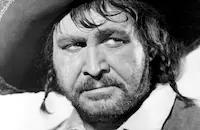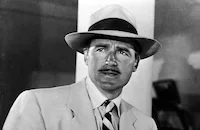Torchy Blane in Chinatown

Brief Synopsis
Cast & Crew
William Beaudine
Glenda Farrell
Barton Maclane
Tom Kennedy
Henry O'neill
Patric Knowles
Film Details
Technical Specs

Synopsis
The friendly rivalry between newspaper reporter Torchy Blane and her pal, police lieutenant Steve McBride, escalates as the two investigate a death threat involving priceless jade tablets brought to the United States on behalf of Senator Baldwin by three adventurers. A note, written in Chinese characters, warns the trio of impending doom at midnight unless a ransom is paid for the tablets, which have been stolen. That night, Torchy joins Steve at the Adventurers Club, where he and his assistant, Gahagan, are guarding the threatened victims--Fitzhugh, Mr. Mansfield and Captain Condon. Once safely past midnight, they leave, but shortly afterward, Fitzhugh is machine-gunned in his car. A note found in the car warns that Mansfield will be the next to die, and despite every possible precaution, he smokes a poisoned cigarette and expires. Before the coroner arrives, Mansfield's body mysteriously vanishes. The next threat occurs when Dick Staunton, the fiancé of Baldwin's daughter Janet, is ordered by the mysterious menace to deliver the $250,000 ransom to the last buoy in New York harbor. Torchy, who has discovered that Fitzhugh's fingerprints and those of the body in the morgue do not match, joins Steve in a submarine as Dick rides out to pay the ransom. At the appointed rendezvous, Torchy and Steve surface in the submarine just in time to save Dick and prove that the murders were all part of a plot by the adventurers to extort money from Baldwin.

Director
William Beaudine
Cast

Glenda Farrell

Barton Maclane

Tom Kennedy

Henry O'neill

Patric Knowles

James Stephenson
Janet Shaw
Frank Shannon
George Guhl
Anderson Lawlor
Richard Bond
Ed Chandler
Eddie Lee

Jack Mower
Cliff Saum
Charles Hickman
Bruce Mitchell
John Harron
Sol Gorss
Alice Connor
Tetsu Komai
Roger Gray
Gordon Hart
Eric Wilton

Lee Phelps
Vera Lewis
Leo White
Frank Mayo

John Ridgely
Ed Mortimer
Crew
George Bricker
Bryan Foy
Will Jenkins
Murray Leinster
Arthur Lueker
Warren Lynch
Lincoln Lyons
Charles Novi
Frederick Richards
Henry Seymour
Howard Shoup
Jack L. Warner

Film Details
Technical Specs

Articles
Torchy Blane in Chinatown
Torchy Blane was born as Kennedy, a fast-talking male reporter in a series of pulp magazine stories by Frederick Nebel. For the screen, however, Kennedy underwent a name and gender change to become the ultimate in news hens. To raise the stakes as she set out to solve the mysteries the police can't, the writers made her the fiancee of the police detective usually assigned to the case. The first Torchy Blane film, Smart Blonde (1937), was the only one adapted from one of Nebel's stories. For this entry, in which she investigates a blackmail case, they drew on a story by Murray Leinster called "The Purple Hieroglyph." Even thought the studio billed it as an original story, it had been filmed twice before -- as The Purple Cipher (1920) and Murder Will Out (1930). In fact, Torchy Blane in Chinatown even uses some of the same character names as the earlier versions, though the original female lead was changed to a supporting role to focus on the reporter. Curiously, Warners credited the story to Leinster and Will Jenkins, who were the same man. Jenkins was Leinster's pen name when he published the original story.
The heart of the Torchy Blane series was Glenda Farrell, one of the most dependable contract performers at Warner Bros. After years on stage -- first as a child actress, then as a leading lady -- she signed with Warner Bros. to re-create her acclaimed stage performance as a chorus girl who has a baby in Life Begins (1932). On screen, Farrell was considered too brassy for major leading roles. She usually played supporting parts in A pictures and starred in the Bs. But she had triumphed as the wise-cracking girl reporter in the horror hit Mystery of the Wax Museum (1933), so she was a natural when they decided to launch the Torchy Blane series. One talent that served her well in the films was her ability to rattle off dialogue. She was once clocked at a record 390 words a minute (most people speak at 120-150 wpm). She also did her homework, talking to real newswomen to get a sense of the woman behind the notepad. As a result, her seven Torchy Blane films (there were two others, one with Lola Lane, the other with Jane Wyman) are considered the best of the series.
Helping to keep things moving was one of Hollywood's most accomplished B-movie directors, William Beaudine, who worked so quickly he earned the nickname "One Shot." Beaudine had done one earlier entry in the series, Torchy Gets Her Man (1938). Like Hitchcock, he edited in the camera, making only the shots he knew would end up in the final film. Where Hitchcock did it to control his films, however, Beaudine did it to save money. And though he rarely got out of low-budget films, he worked all the time, directing more than half of the Bowery Boys movies of the '40s and '50s. He also turned in some true cinematic curiosities -- including the early exploitation film Mom and Dad (1945), the horror comedy Bela Lugosi Meets a Brooklyn Gorilla (1952) and the horror westerns Jesse James Meets Frankenstein's Daughter and Billy the Kid versus Dracula (both 1966) -- that have unjustly earned him a reputation as one of the screen's worst directors. One look at the fast-paced action of Torchy Blane in Chinatown, however, should be enough to clear that reputation.
Producer: Bryan Foy
Director: William Beaudine
Screenplay: George Bricker
Based on the story "The Purple Hieroglyph by Murray Leinster and Will Jenkins [credited as an original story]
Cinematography: Warren Lynch
Art Direction: Charles Novi
Principle Cast: Glenda Farrell (Torchy Blane), Barton MacLane (Det. Lt. Steve "Mac" MacBride), Tom Kennedy (Det. Sgt. Gahagan), Henry O'Neill (Sen. H. Baldwin), Patric Knowles (Capt. Condon), James Stephenson (Dr. Mansfield), Janet Shaw (Janet Baldwin), Victor Sen Yung (Chinese Entertainer With Sword).
BW-58m.
by Frank Miller

Torchy Blane in Chinatown
Quotes
Trivia
Although the onscreen credits state this is an original story, it is actually a remake of _Murder Will Out (1930)_, which has a virtually identical plot, and uses many of the same character names.
The print actually credits the "original story" to Murray Leinster and Will Jenkins. Perhaps the filmmakers didn't realize that Murray Leinster is a pseudonym of Will Jenkins, but it was probably just an inside joke.
Lee Phelps is credited in studio records as Detective, but he was not seen in the movie.
Notes
A working title for this film was Torchy in Chinatown. Although the film's title card reads: "Based on the characters created by Frederick Nebel," modern sources call the film a remake of the 1930 First National film Murder Will Out (see AFI Catalog of Feature Films, 1921-30; F2.3730), which was based on the short story "The Purple Hierogplyph" by Will Jenkins in Snappy Stories (1 March 1920). The plots of the two films are very similar. Hollywood Reporter production charts list Joe Cunningham in the cast, but his appearance in the released film has not been confirmed. For additional information on the "Torchy Blane" series, consult the Series Index and see entry above for Smart Blonde.
















